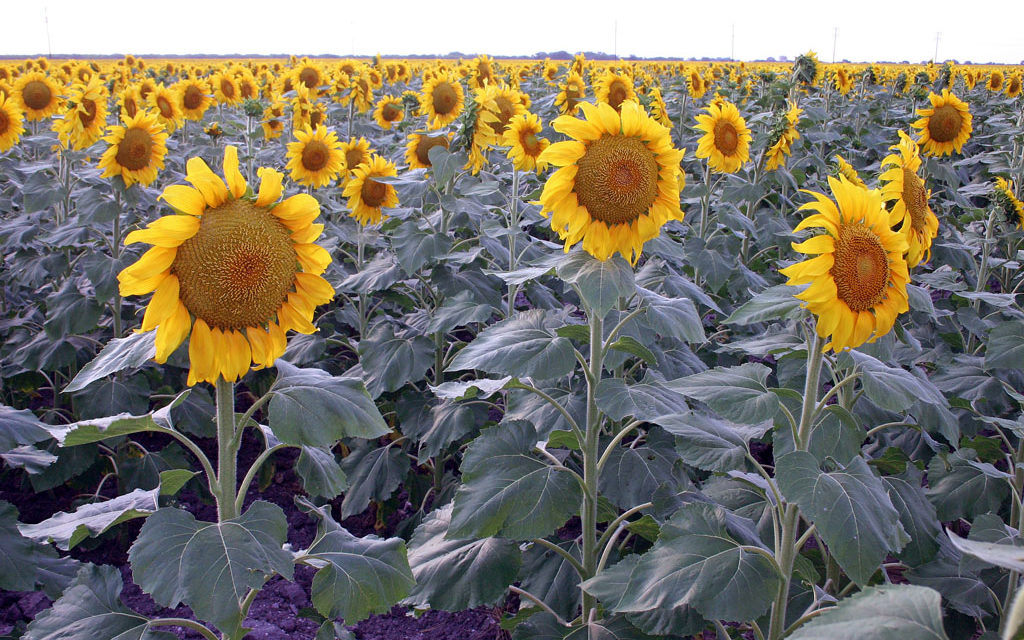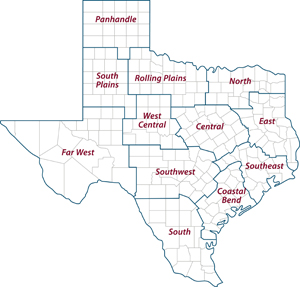by Adam Russell
Oilseed crops like sunflowers and canola are experiencing lower prices, but it appears overall interest in alternative crops remains steady, said a Texas A&M AgriLife Extension Service expert.
Dr. Calvin Trostle, AgriLife Extension agronomist, Lubbock, said alternative crop options such as sunflowers, sesame, canola and guar remain minor crops, but their viability due to drought and heat tolerance may increase their popularity as market demands rise.
Trostle said there is a large oversupply of confectionary sunflower seeds, which are the edible snack seeds, due to high and even record-breaking national yields per acre the past few years. Oversupply has hurt prices and demand for planted acres this year.
“One commodity broker in Lubbock typically contracts up to 40,000 acres in the Texas High Plains, but they contracted none this year,” Trostle said. “Regional prices are lower, so this means acres will go elsewhere. Growers don’t plant sunflowers unless they’re under contract, because otherwise there are no assurances there will be anyone to buy their crop.”
Prices are fair at best for oilseed sunflower, and the Texas oilseed acreage is expected to be down to about 35,000 acres from 50,000 acres or more.
Planted acres include up to 9,000 acres in the Lower Rio Grande Valley for export to Mexico and about 20,000 acres for bird seed production.
With sesame, current contract acreage is limited to one company, Trostle said. He is uncertain about sesame acreage, but said it appears Texas production could be in the range of 50,000 acres to as much as 100,000 acres. Trostle said there could be some increased export demand from Japan, which recently reduced import regulations on the crop.
A second company is conducting test plantings with new non-shattering varieties to evaluate possible expansion of sesame in West Texas in the near future, he said.
The northern Texas Rolling Plains has some winter canola production. But one canola limitation in the region is the planting window, which closes early in October when some producers have not harvested summer crops like cotton.
Canola offers a rotational crop option to wheat in fields with grassy weeds that would be a potential problem, Trostle said. But canola also requires more management than wheat.
There is current interest in re-examining the spring canola potential on the lower Texas Gulf Coast, Trostle said. This area was a production region for spring canola through the 1980s.
Prices have fallen for another minor oilseed, guar, since the market ballooned in 2013, said Trostle.
Texas guar producers are expected to increase acreage by as much as 30 percent this season, he said. Guar prices continue to be low, but there is great interest in the heat and drought tolerant crop. The U.S. Department of Agriculture is providing $1.2 million across four research grants focused on the crop or in conjunction with other minor crops.
“Guar prices tend to follow petroleum production because it is used in the drilling process,” he said. “There is a huge market for it when drilling is active, and there is interest in it as a food-grade emulsifier. Guar is drought and heat tolerant, so there’s plenty of areas in Texas where it could be a successful crop.”
AgriLife Extension district reporters compiled the following summaries:
CENTRAL: Much-needed rain was received. Conditions improved because of the rainfall. Most cattle producers were having to supplement with hay and/or cubes. The rainfall should get most counties through a first hay cutting and some much-needed grazing. Wheat and oats were almost grazed out. Most grain sorghum was planted. Cotton planting started. Livestock producers were fertilizing and spraying weeds in pastures. Livestock were in good body condition. Tanks started to fill up. Nearly all counties reported good soil moisture. Overall crop, rangeland and pasture conditions were good in nearly all counties.
ROLLING PLAINS: Rainfall was received, and some western counties reported totals 0.8-2.5 inches, but more rain was needed. One county reported hail. Wheat that wasn’t cut and baled showed improvement. The moisture should help forages going into the hot summer months. Farmers were trying to prepare fields and put out pre-emergence herbicides, but were not in any hurry to start planting cotton. Producers plan to hold off as long as they can in hopes of more rain before the June 20 final plant date. Cattle producers were battling lice and ticks. Ranchers were turning cattle on winter wheat in hopes of holding onto herd numbers. Some were still supplementing cake trying to improve poor body condition scores.
COASTAL BEND: Weather was warm, windy, humid and very dry. Soil moisture conditions were critical for row crops, rangeland and pastures. Some cotton was re-planted due to wind damage, and rice planting should finish soon. Producers sprayed for weeds in row crops. Cattle remained in good condition. Hay supply levels remained adequate.
EAST: No report.
SOUTH PLAINS: Windy, hot and dry conditions continued. Planting of cotton, peanuts and other crops was in full swing. Corn and oats were in fair to good condition. Pasture, rangeland and winter wheat were in poor condition and needed moisture.
PANHANDLE: Conditions were warm, dry and windy. Ochiltree County received rain but conditions remained dry. Moisture was needed throughout the district. Corn planting was starting but was behind cotton planting this year. Producers were not in a hurry to plant this year due to dry weather and lack of soil moisture. Some producers started prewatering for upcoming plantings. Winter wheat was at all stages from boot to blooming. Silage trucks were starting to run with choppers in early planted wheat fields. Warmer temperatures were on the way, and without rain conditions were expected to worsen quickly. Rangelands were greening up slower than normal for this time of year.
NORTH: Topsoil and subsoil moisture levels were mostly adequate across the counties. Another 0.5-2.5 inches of rain was reported in most counties, along with warmer temperatures. Soil conditions were good, and the warm-season grasses were starting to grow. Winter grasses peaked and were cut for hay in some areas. Wheat and oats producers were making silage and haylage, and some were baling and producing good yields. Wheat was in the dough stage. Corn looked good and was about 1.5 feet tall. Milo and soybeans were coming up and thriving. Pastures were doing better after warmer temperatures. Cattle and stockers were in great condition. Horn flies were beginning to be a problem, and feral hog activity was reported.
FAR WEST: Temperature highs were in the mid-90s with lows in the 50s. Rainfall amounts were less than 0.6 for the district. Severe hail storms were reported. All Pima cotton was planted and most had emerged. Most upland cotton ground was planted. Alfalfa was cut, and many fields were irrigated and prepared for a second cut. Pecan orchards were on their second irrigation and fertilized with no reports of pest pressure, but producers were monitoring for pecan casebearer. Those with planted wheat or oats were having to water heavily. Winter wheat headed out, and most will make hay or be plowed under. Fruit trees were showing fruit. Pastures were very dry, and wildlife were looking for something to eat. Watermelons were off to a poor start due to deer and rabbits.
WEST CENTRAL: A soaking rain followed warm, windy conditions. While the rain was too late to help wheat fields, it will be very beneficial to pastures, grain sorghum, corn, and the upcoming cotton planting. Cotton producers were spraying to control spring weeds, but additional moisture was needed for cotton planting to begin. Despite the rain, most county officials continued with burn bans.
SOUTHEAST: Livestock were in good condition. Cotton was not growing and looked poor, but was doing better with warm temperatures and sunny days. Corn and sorghum were doing well. Row crop farmers were side dressing fertilizer and making herbicide applications in cotton fields. Most hay fields were fertilized and sprayed for weeds. Small grain harvests had not begun yet. Rangeland and pasture ratings were excellent to poor with good ratings most common. Soil moisture levels ranged from adequate to very short with adequate being most common.
SOUTHWEST: Weather was favorable for rangeland and pastures with a small amount of rainfall received. More rain was forecast. Livestock remained in good condition. Recent rains will help livestock and wildlife water availability. Cattle prices were low, and producers were hoping recent rains will help prices. Rust was in wheat. Peaches looked good. Many hay fields were fertilized in anticipation of rain.
SOUTH: Most of the district reported mild and dry weather conditions with short moisture levels. Southernmost counties reported hot, dry conditions with short to very short moisture levels. Several counties received traces of rain up to 4 inches. More rain was forecast for some areas. Wheat, oats and red potato harvest continued. Cotton planting was complete and the crop had emerged. Corn fields were in the slicking stage. Pasture and rangeland conditions were fair to poor, and should improve in areas with rainfall and decline in areas without. Body condition scores on cattle remained in good to fair condition. La Salle County reported no rice or soybeans planted due to drought. Crops looked good, especially Coastal Bermuda grass and vegetables. Producers were providing supplements and hay to reduce grazing pressure. Some earlier planted wheat fields were ready for harvest as soon as fields dried. Cotton, corn, sorghum and cabbage made good progress. Water hauling and supplemental feeding continued in areas that did not receive rain, and some producers began to reduce livestock numbers. Farmers reported corn was taking a hit on yields already, and cotton was sitting stagnant with the lack of rainfall and heat units. A few hay fields were harvested, but quality was less than desirable. Numbers at local sale barns were up for all classes of beef cattle, and an abnormally high number of cow/calf pairs were sold. Prices were steady to slightly down for all classes of beef cattle. Live cattle market demand increased bringing higher prices with it. Hidalgo County reported the sugarcane harvest was close to beginning, and citrus harvest was winding down. The onion harvest was active, and the melon harvest was beginning.








